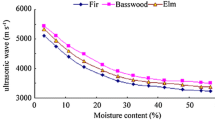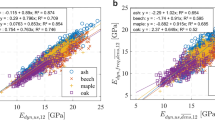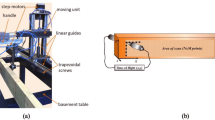Summary
Because wood is a natural material, the variability of its properties is very large. In order to use wood efficiently in building, it has to be stress graded. The ultrasonic stress grading was developped as an improved alternative to visual grading. This non destructive evaluative technique allows reliable higher strength values while working with new products. Corrected models were studied to reference the ultrasonic propagation speed at constant moisture content and temperature. Using a referential ultrasonic wave velocity, stress grading can be carried out on trees or logs before cutting, or on fresh beams. The correlation between conditioned beams and test specimens is very high, especially for the strongest material.
Similar content being viewed by others
References
DIN 4074, 1989: Gütebedingungen für Nadelschnittholz. Sortierung nach der Tragfähigkeit. Ed. Beuth-Verlag
Dunlap, M. E.; Bell, E. R. 1951: Electrical moisture meters for wood. US. Dep. Agr., For. Prod. Lab. Rep. M. R1160, Madison, Wi., USA
Kessel, M. H.; Sandoz, J. L. 1989: Zur Effizienz der Festigkeitssortierung von Fichtenkantholz. Teil 1: Vergleich europäischer Normen. Holz als Roh-und Werkstoff 47: 279–284
Keylwerth, R.; Noack, D. 1956: Über den Einfluß höherer Temperaturen auf die elektrische Holzfeuchtigkeitsmessung nach Widerstandsprinzip. Holz and Rohals Werkstoff 14: 162–172
Kollmann, F. P.; Krech, H. 1960: Dynamische Messungen der elastischen Holzeigenschaften und der Dämpfung. Holz als Roh-und Werkstoff 18: 41–54
Larsen, H. J. 1991: An Introduction to Eurocode 5. Int. Timber Eng. Conf., Sept., London, UK
NF 52001.1, 1987: Règles d'utilisation du bois dans les constructions. Ed. AFNOR, Tour Europe, 920080 Paris, F
Panshin, A. J.; de Zeeuw, C. 1980: Textbook of Wood Technology. Ed. McGraw-Hill Book Company
Rilem, 1978: Materials and Structures n∘ 66, Nov., Dec., Ed. Dunod
Samson, M. 1986: Predicted and actual performance of two laboratory stress-grading machines employing different support conditions. Wood and Fiber sc. 17(4): 478–489
Sandoz, J. L. 1989: Grading of construction timber by ultrasound. Wood sci. and Technology 23: 95–108
Sandoz, J. L. 1991: Non-destructive Evaluation for Building Timber. Visual and Ultrasound Grading. In. Timber. Eng. Conf., Sept., London, UK
Seber, G. A. F. 1977: Linear regression analysis. Ed. John Wiley & Sons
SIA 553164, 1981: Construction en bois. Ed. SIA, CP 8039 Zurich, CH
Snodgrass, D. V. 1978: Development of a Proof Loading Machine for Quality Control of MSR Lumber. 4th Non-dest. Testing of Wood Symp., Vancouver, Wa., USA
Author information
Authors and Affiliations
Additional information
The author wishes to thank the Swiss Federal Institute of Technology Lausanne for acceptance of his doctoral thesis work, June 1990
Rights and permissions
About this article
Cite this article
Sandoz, J.L. Moisture content and temperature effect on ultrasound timber grading. Wood Sci.Technol. 27, 373–380 (1993). https://doi.org/10.1007/BF00192223
Received:
Issue Date:
DOI: https://doi.org/10.1007/BF00192223




